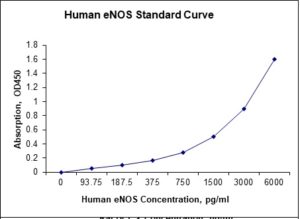Nori Human eNOS ELISA Kit
$461.00 – $832.00
This ELISA kit is for quantification of eNOS in human. This is a quick ELISA assay that reduces time to 50% compared to the conventional method, and the entire assay only takes 3 hours. This assay employs the quantitative sandwich enzyme immunoassay technique and uses biotin-streptavidin chemistry to improve the performance of the assays. An antibody specific for NOS3 has been pre-coated onto a microplate. Standards and samples are pipetted into the wells and any NOS3 present is bound by the immobilized antibody. After washing away any unbound substances, a detection antibody specific for NOS3 is added to the wells. Following wash to remove any unbound antibody reagent, a detection reagent is added. After intensive wash a substrate solution is added to the wells and color develops in proportion to the amount of NOS3 bound in the initial step. The color development is stopped, and the intensity of the color is measured.
Alternative names for eNOS: Endothelial NOS (eNOS), nitric oxide synthase 3 (NOS3), constitutive NOS (cNOS),
This product is for Laboratory Research Use Only not for diagnostic and therapeutic purposes or any other purposes.
- Description
- How Elisa Works
- Product Citation (0)
- Reviews (0)
Description
Nori Human eNOS ELISA Kit Summary
Alternative names for eNOS: Endothelial NOS (eNOS), nitric oxide synthase 3 (NOS3), constitutive NOS (cNOS),
| Assay Type | Solid Phase Sandwich ELISA |
| Format | 96-well Microplate or 96-Well Strip Microplate |
| Method of Detection | Colorimetric |
| Number of Targets Detected | 1 |
| Target Antigen Accession Number | P29474 |
| Assay Length | 3 hours |
| Quantitative/Semiquantitative | Quantitative |
| Sample Type | Plasma, Serum, Cell Culture, Urine, Cell/Tissue Lysates, Synovial Fluid, BAL, |
| Recommended Sample Dilution (Plasma/Serum) | No dilution for sample <ULOQ; sufficient dilution for samples >ULOQ |
| Sensitivity | 18 pg/mL |
| Detection Range | 93.75-6000 pg/mL |
| Specificity | Human eNOS |
| Cross-Reactivity | < 0.5% cross-reactivity observed with available related molecules, < 50% cross-species reactivity observed with species tested. |
| Interference | No significant interference observed with available related molecules |
| Storage/Stability | 4 ºC for up to 6 months |
| Usage | For Laboratory Research Use Only. Not for diagnostic or therapeutic use. |
| Additional Notes | The kit allows for use in multiple experiments. |
Standard Curve
Kit Components
1. Pre-coated 96-well Microplate
2. Biotinylated Detection Antibody
3. Streptavidin-HRP Conjugate
4. Lyophilized Standards
5. TMB One-Step Substrate
6. Stop Solution
7. 20 x PBS
8. Assay Buffer
Other Materials Required but not Provided:
1. Microplate Reader capable of measuring absorption at 450 nm
2. Log-log graph paper or computer and software for ELISA data analysis
3. Precision pipettes (1-1000 µl)
4. Multi-channel pipettes (300 µl)
5. Distilled or deionized water
Protocol Outline
1. Prepare all reagents, samples and standards as instructed in the datasheet.
2. Add 100 µl of Standard or samples to each well and incubate 1 h at RT.
3. Add 100 µl of Working Detection Antibody to each well and incubate 1 h at RT.
4. Add 100 µl of Working Streptavidin-HRP to each well and incubate 20 min at RT.
5. Add 100 µl of Substrate to each well and incubate 5-30 min at RT.
6. Add 50 µl of Stop Solution to each well and read at 450 nm immediately.
Background:
Endothelial NOS (eNOS), also known as nitric oxide synthase 3 (NOS3) or constitutive NOS (cNOS), is an enzyme that in humans is encoded by the NOS3 gene.[1] This enzyme is one of three isoforms that synthesize NO, a small gaseous and lipophilic molecule that participates in several biological processes.[2] The other isoforms include neuronal NOS (nNOS), which is constitutively expressed in specific neurons of the brain[3] and inducible NOS (iNOS), whose expression is typically induced in inflammatory diseases.[4] eNOS is primarily responsible for the generation of NO in the vascular endothelium,[5] a monolayer of flat cells lining the interior surface of blood vessels, at the interface between circulating blood in the lumen and the remainder of the vessel wall. NO produced by eNOS in the vascular endothelium plays crucial roles in regulating vascular tone, cellular proliferation, leukocyte adhesion, and platelet aggregation. Therefore, a functional eNOS is essential for a healthy cardiovascular system. eNOS expression and activity are carefully controlled by multiple interconnected mechanisms of regulation. eNOS is attached by myristoylation and palmitoylation to caveolae, a pocket-like invagination on the membrane rich in cholesterol and sphingolipids.[6] With the binding of eNOS to caveolae, the enzyme is inactivated due to the strong and direct interaction of eNOS with caveolin-1.[7] The binding of calcium-activated calmodulin to eNOS displaces caveolin-1 and activates eNOS. Moreover, eNOS activation is dynamically regulated by multiple phosphorylation sites.[8] Impaired NO production is involved in the pathogenesis of several diseases such as hypertension, preeclampsia, diabetes mellitus, obesity, erectile dysfunction, and migraine.
References
- Marsden PA, et al. (1992). FEBS Lett. 307 (3): 287–93.
- Villanueva C, Giulivi C (2010). Free Radical Biology & Medicine. 49 (3): 307–16.
- Förstermann U, Sessa WC (2012). European Heart Journal. 33 (7): 829–37, 837a–837d.
- Oliveira-Paula GH, et al. (2014). Current Drug Targets. 15 (2): 164–74.
- Fish JE, Marsden PA (2006). Cellular and Molecular Life Sciences. 63 (2): 144–62.
- Lisanti MP, et al. (1994). Trends in Cell Biology. 4 (7): 231–5.
- Ju H, Zou R, et al. (1997). The Journal of Biological Chemistry. 272 (30): 18522–5.
- Qian J, Fulton D (2013). Frontiers in Physiology. 4: 347.
Be the first to review “Nori Human eNOS ELISA Kit”
You must be logged in to post a review.





























Reviews
There are no reviews yet.